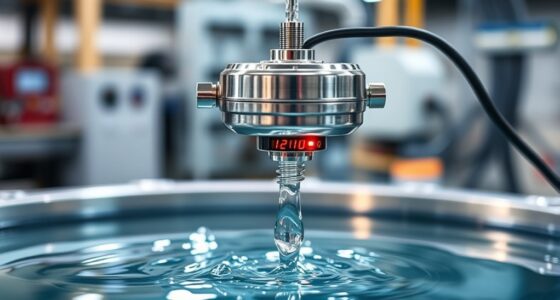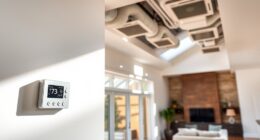Seismic joints in infinity pools let your structure move safely during earthquakes, preventing cracks and water leaks. They absorb ground shifts and seismic forces, ensuring your pool stays durable and beautiful. Properly designed and installed, these joints offer flexibility and resilience, reducing the risk of costly repairs. To keep your pool in top shape, regular inspection and maintenance are key. Keep exploring to discover how the right joints protect your investment and enhance your pool’s longevity.
Key Takeaways
- Properly installed seismic joints accommodate ground shifts, preventing cracks and leaks in infinity pools during seismic events.
- Use flexible materials like rubber or elastomeric compounds to absorb seismic movements effectively.
- Strategic placement of joints at stress points ensures controlled movement and maintains structural integrity.
- Regular inspection and maintenance detect early signs of wear, cracks, or displacement, ensuring long-term resilience.
- Incorporating seismic-resistant design features enhances safety, durability, and aesthetic appeal during ground movements.
Understanding the Role of Seismic Joints in Infinity Pools

Seismic joints play a crucial role in ensuring the safety and durability of infinity pools, especially in earthquake-prone areas. These specially designed gaps allow the pool structure to move independently from surrounding buildings or terrain during seismic activity. By absorbing and accommodating movements, seismic joints prevent cracks, leaks, and structural damage that earthquakes can cause. They act as a buffer, distributing stress evenly and reducing the risk of catastrophic failure. Properly installed seismic joints also help maintain the pool’s aesthetic appeal by preventing unsightly cracks. Without these joints, the constant flexing caused by ground shifts could compromise the pool’s integrity over time. Additionally, understanding the importance of noise levels of modern heat pumps can contribute to maintaining a peaceful environment around your pool area. In short, seismic joints are essential components that protect your infinity pool from the unpredictable forces of nature, ensuring longevity and safety.
How Seismic Movements Impact Pool Structures
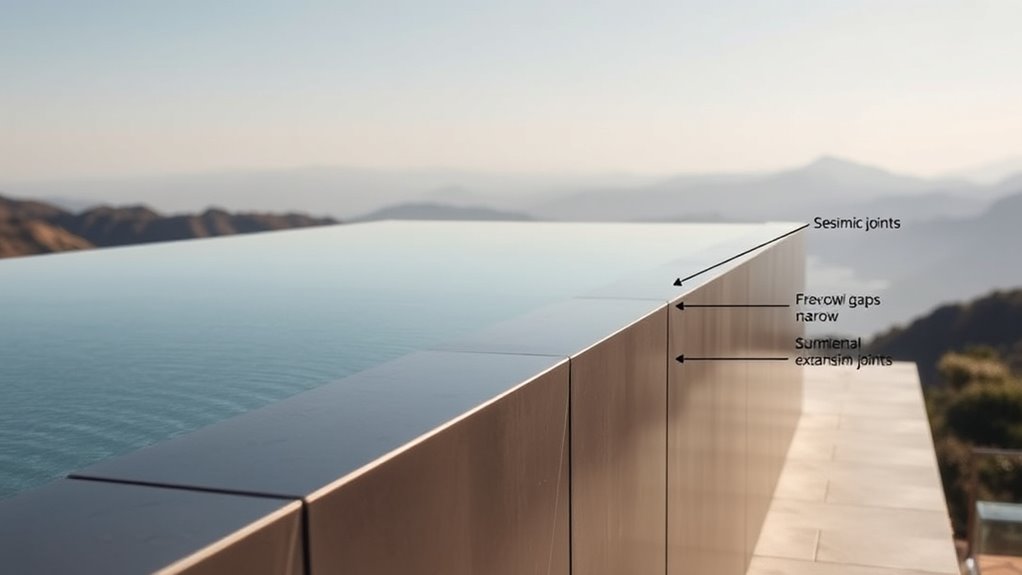
Seismic movements put significant stress on your pool walls, which can cause cracking or damage if not properly managed. Flexibility in your pool’s design allows it to absorb these movements without breaking. Understanding how seismic activity affects your pool helps you choose the right features to protect it. Incorporating structural reinforcement techniques can further enhance your pool’s ability to withstand seismic forces.
Seismic Stress on Pool Walls
When earth movements occur unexpectedly, pool walls experience significant stress that can compromise their integrity. The shifting ground exerts lateral forces, pushing and pulling on the structure. These forces can cause cracking, displacement, or even failure if the pool isn’t properly designed to absorb them. Heavy seismic activity amplifies these stresses, especially if the walls are rigid and lack flexibility. Sudden shifts can create pressure points, weakening joints and seams. Without proper mitigation, these stresses may lead to leaks or structural collapse. Recognizing how seismic forces impact your pool walls helps you understand the importance of incorporating seismic considerations into design. Effective strategies ensure your pool withstands ground movements without damage, keeping your structure safe and functional during unexpected seismic events. Additionally, integrating seismic design principles can further improve the resilience of pool structures against ground movements.
Flexibility in Structural Design
Because ground movements can be unpredictable and forceful, designing pool structures with flexibility becomes essential to prevent damage. Flexibility allows your pool to absorb seismic forces without cracking or shifting dangerously. Incorporate expansion joints, flexible materials, and engineered slip planes into your design to accommodate movement. These features enable the structure to adapt to ground shifts, reducing stress on the concrete and finishes. Using reinforced concrete with ductile properties also helps the pool withstand seismic forces. Proper detailing ensures that movement is controlled and directed safely, avoiding structural failure. Material selection plays a crucial role in enhancing the resilience of your pool to seismic activity. Emphasizing flexibility in your design not only enhances safety but also extends the lifespan of your infinity pool, ensuring it remains a stunning, stable feature even during seismic events.
Types of Seismic Joints Suitable for Infinity Pools

Selecting the right seismic joints for your infinity pool is essential to accommodate ground movements without compromising its aesthetic and structural integrity. Typically, you’ll encounter expansion joints, which allow for thermal expansion and contraction, and movement joints designed specifically for seismic activity. These joints can be made from flexible materials like rubber or silicone, which absorb movement and prevent cracks. Sliding joints are also effective, permitting horizontal shifts while maintaining water tightness. For pools on unstable ground, flexible bellows or modular joints can provide extra adaptability. Each type helps distribute seismic forces evenly, reducing stress on your pool’s structure. Choosing the appropriate seismic joint depends on your pool’s size, location, and expected ground movement, ensuring safety without sacrificing appearance. Incorporating proper installation techniques is crucial for optimal performance and longevity of the seismic joints.
Key Factors in Installing Seismic Joints Properly
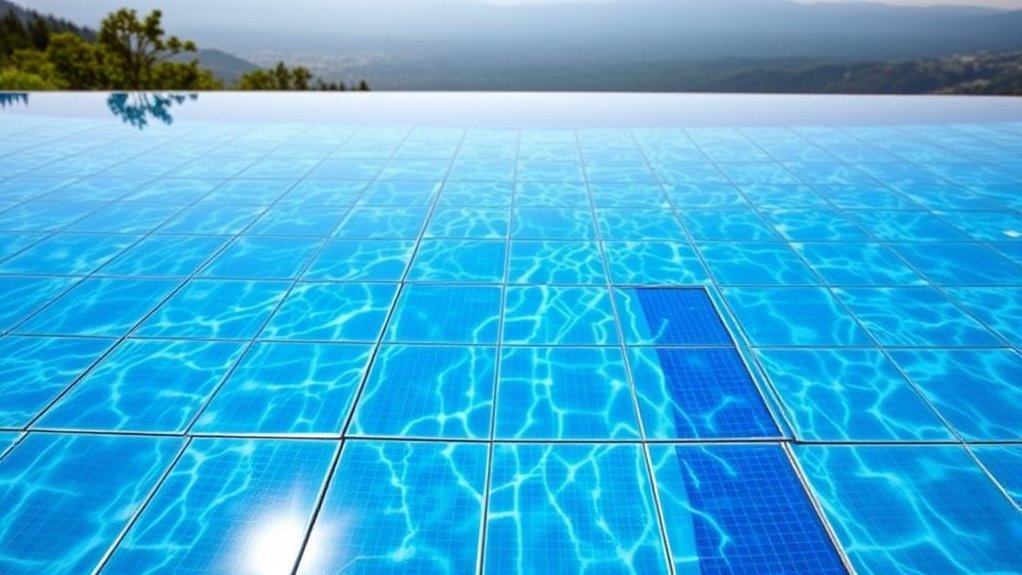
Proper installation of seismic joints guarantees they function effectively during ground movements, protecting your pool’s structural integrity. To achieve this, verify the joints are correctly positioned at stress points where movement is most likely. You should follow manufacturer guidelines carefully, paying close attention to depth and alignment. Proper sealing is vital to prevent water ingress and debris buildup, which can compromise flexibility. Make sure the substrate beneath the joint is stable and well-prepared to support the joint’s movement. Properly inflating tires and maintaining the correct pressure can help prevent uneven settling or damage to the installation. Regular inspection during and after installation helps identify potential issues early. Avoid shortcuts, as improper placement or inadequate sealing can lead to cracking or failure during seismic activity. Precise installation ensures your infinity pool remains resilient, maintaining its beauty and safety over time.
Materials Used in Seismic Joints for Enhanced Flexibility

Materials used in seismic joints are essential for guaranteeing the necessary flexibility to accommodate ground movement without damaging your infinity pool. You want materials that can absorb and expand with shifting earth, preventing cracks or structural failure. Rubber and elastomeric compounds are popular choices because they provide excellent flexibility and resilience. These materials can withstand repeated movements without losing their properties. Additionally, high-performance sealants and flexible polymers help maintain waterproof integrity while allowing movement. Metal components, such as sliding plates or flexible joints, are often combined with elastomers to enhance durability. The key is selecting materials that balance flexibility, strength, and longevity, so your pool remains safe and functional during seismic activity. Proper material selection ensures your infinity pool can move with the ground, not against it. Incorporating flexible building materials that mimic the natural movement of earth can further improve the performance of seismic joints over time.
Design Considerations for Seismic-Resistant Infinity Pools

Designing a seismic-resistant infinity pool requires careful planning to guarantee it can withstand ground movements without compromising its aesthetic appeal or structural integrity. You should select flexible materials and joints that absorb seismic forces without cracking or shifting. Consider the pool’s foundation and ensure it’s reinforced to handle lateral stresses. Incorporate expansion joints strategically to allow movement while maintaining a seamless look. Pay attention to the pool’s load distribution, avoiding overly rigid structures that could transfer stresses unevenly. Use shock-absorbing elements where necessary, especially around critical connections. Keep aesthetic harmony in mind; choose design elements that blend safety features seamlessly into your pool’s visual appeal. Proper planning ensures your infinity pool remains a stunning, resilient feature, even in the face of seismic activity. Additionally, selecting seismic-resistant construction techniques can significantly improve the pool’s ability to withstand ground movements.
Maintenance and Inspection of Seismic Joints
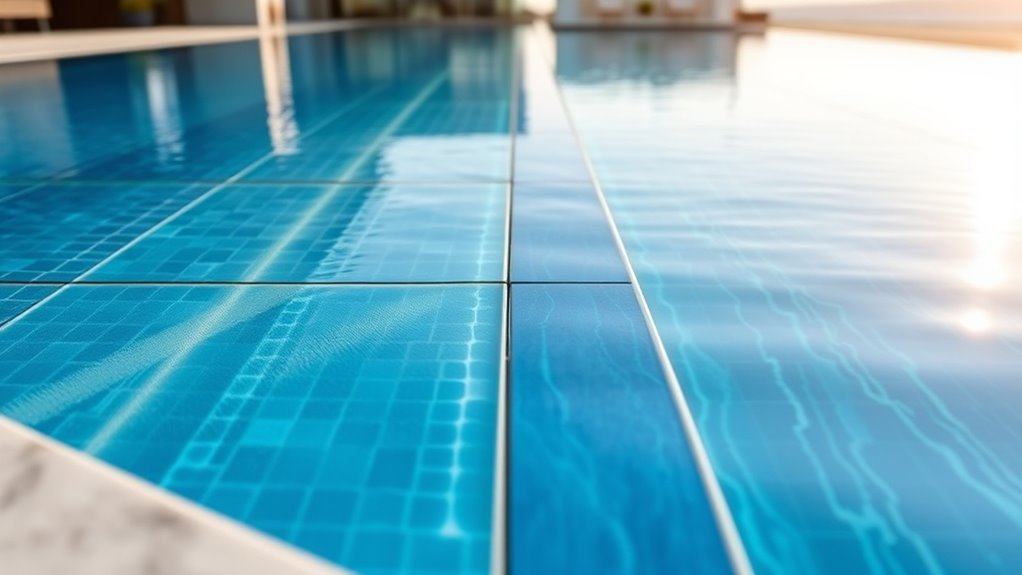
Regular maintenance and thorough inspection of seismic joints are essential to guarantee your infinity pool remains safe and functional after seismic events. You should check the joints regularly for signs of wear, cracking, or debris buildup that could hinder movement. Ensure the joints are free of dirt and obstructions, and verify that sealants are intact and flexible. During inspections, look for any displacement or deformation that might indicate stress or damage. Promptly address issues like cracks or leaks to prevent further deterioration. Keep detailed records of inspections and repairs, so you can track changes over time. Regular upkeep helps maintain the integrity of the seismic joints, reducing the risk of costly repairs and ensuring your infinity pool stays resilient during seismic activity. Additionally, inspecting for signs of spoilage such as mold or discoloration can help prevent issues related to compromised materials or components.
Benefits of Incorporating Seismic Joints in Your Luxury Pool

Incorporating seismic joints into your luxury pool can ensure its structural integrity, helping it withstand seismic movements. These joints also reduce the risk of cracking, protecting your investment over time. By adding seismic joints, you ensure your pool remains both beautiful and durable for years to come. Additionally, understanding cost-effective design solutions can help you optimize the installation of seismic joints while staying within budget.
Enhanced Structural Integrity
Seismic joints play a crucial role in enhancing the structural integrity of your luxury infinity pool by allowing controlled movement during seismic events or temperature fluctuations. This flexibility helps prevent stress buildup that can cause cracks or failures. By incorporating seismic joints, you benefit from:
- Reduced Risk of Structural Damage – movement is absorbed safely, safeguarding your pool’s foundation.
- Longevity of Your Investment – the pool remains durable over time with minimized wear.
- Maintained Aesthetic Appeal – cracks and deformations are avoided, keeping your pool pristine.
- Improved Safety – a stable structure reduces hazards during sudden ground shifts or temperature changes.
Minimized Cracking Risks
Have you ever wondered how to prevent cracks from damaging your luxury infinity pool? Incorporating seismic joints substantially reduces this risk by allowing controlled movement within the structure. These joints absorb shifts caused by temperature changes, settling, or seismic activity, preventing stress buildup that leads to cracking. Without seismic joints, the constant expansion and contraction can create tension points, eventually causing fractures. By strategically placing these joints, you create a flexible connection that accommodates natural movement, preserving your pool’s pristine appearance and structural integrity. This proactive approach minimizes costly repairs and downtime. Ultimately, seismic joints act as a safeguard, ensuring your luxurious infinity pool remains flawless, even under environmental stresses. Protect your investment and enjoy peace of mind with this effective crack prevention strategy.
Frequently Asked Questions
How Do Seismic Joints Affect Pool Aesthetics?
Seismic joints can subtly influence your pool’s aesthetics by creating visible lines or gaps that blend into the design or stand out, depending on how they’re integrated. When professionally installed, they minimize movement and cracking, maintaining a sleek appearance. You might notice slight divisions, but overall, seismic joints ensure your infinity pool remains beautiful and functional, even during seismic activity. Proper design and placement help safeguard your pool’s visual appeal.
Are Seismic Joints Compatible With Various Infinity Pool Designs?
Yes, seismic joints are compatible with various infinity pool designs. You can incorporate them seamlessly into different styles, whether sleek modern, naturalistic, or traditional. They’re flexible and adaptable, allowing you to maintain your pool’s aesthetic while guaranteeing safety and structural integrity. By choosing the right type and placement, you assure your infinity pool remains stunning and resilient, regardless of its design or location.
What Is the Average Lifespan of Seismic Joints in Pools?
You’ll find that seismic joints typically last between 10 to 20 years, depending on factors like climate, pool use, and maintenance. Some worry about replacement costs, but regular inspections and proper upkeep can extend their lifespan. If you stay proactive, these joints continue to protect your infinity pool from damage caused by ground movement, ensuring your stunning view stays intact without costly repairs or disruptions.
Can Seismic Joints Be Retrofitted Into Existing Pools?
Yes, you can retrofit seismic joints into existing pools. First, consult a structural engineer to assess your pool’s current condition and determine the best placement. Then, plan for careful demolition of existing joints or cracks, and install the new seismic joints with precision. This process helps accommodate movement, reducing stress and preventing damage, ensuring your pool remains safe and functional for years to come.
How Do Seismic Joints Influence Pool Maintenance Costs?
Seismic joints can increase your pool’s maintenance costs because they require regular inspection and occasional replacement to guarantee proper function. You’ll need to monitor for leaks or damage around the joints, which might lead to additional repairs. However, their benefits of protecting your pool during earthquakes often outweigh these costs. Proper maintenance can help you avoid bigger issues, saving you money in the long run.
Conclusion
By blending boldness with careful consideration, seismic joints safeguard your stunning infinity pool from seismic surprises. Embrace essential elements, guarantee expert installation, and conduct consistent checkups to keep your luxurious landscape flawless. With wise wisdom and well-placed joints, you’ll weather the waves without worry, welcoming wonder and whimsy into your water wonderland. Seismic safety secures serenity, so you can enjoy your infinity pool’s inspiring infinity—without interruption or upheaval.



